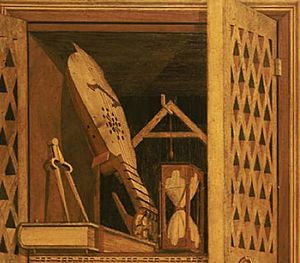Federico da Montefeltro facts for kids
Quick facts for kids
Federico da Montefeltro
|
|
|---|---|
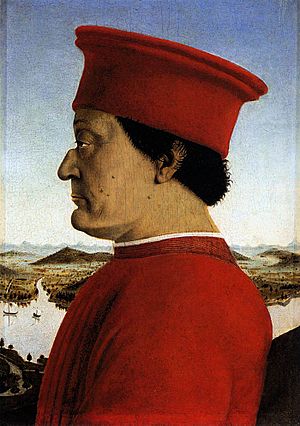
Portrait of Federico da Montefeltro by Piero della Francesca. Federico lost his nasal bridge and his right eye in a tournament.
|
|
| Duke of Urbino | |
| Reign | 22 July 1444 – 10 September 1482 |
| Predecessor | Oddantonio |
| Successor | Guidobaldo I |
| Born | 7 June 1422 Castello di Petroia, Gubbio, Papal States |
| Died | 10 September 1482 Ferrara, Duchy of Ferrara |
| Noble family | House of Montefeltro |
| Spouse(s) |
Battista Sforza
(m. 1460; died 1472) |
| Issue | Costanza di Montefeltro (December 1460 – February 1461) Giovanna di Montefeltro (1462–1514) Isabetta di Montefeltro (c. 1464 – 1521) Costanza di Montefeltro (1466–1518) Violanta di Montefeltro Agnese di Montefeltro (1470–1522) Guidobaldo da Montefeltro (1472–1508) |
| Father | Guidantonio da Montefeltro |
Federico da Montefeltro (born June 7, 1422 – died September 10, 1482) was an important leader during the Italian Renaissance. He was known as a very successful military commander, also called a condottiero (a mercenary captain). He ruled Urbino from 1444 until his death, becoming its Duke in 1474.
Federico was also a smart and cultured man. He loved learning and art, which is part of being a humanist. He built a huge library, one of the biggest in Italy at the time, and gathered many scholars and artists around him. His home, the Ducal Palace in Urbino, was a center for art and knowledge.
Contents
Life Story of Federico da Montefeltro
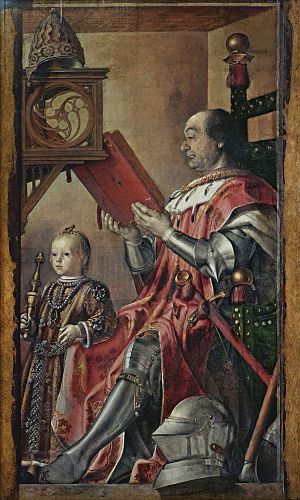
Federico was born in Castello di Petroia in Gubbio. He was the son of Guidantonio da Montefeltro, who ruled Urbino. When Federico was two years old, Pope Martin V officially recognized him as Guidantonio's son.
In 1433, after a peace treaty, Federico lived in Venice and Mantua for a while. In 1437, he became a knight, a special honor given by Emperor Sigismund. That same year, he married Gentile Brancaleoni.
Starting a Military Career
At 16, Federico began his career as a condottiero, leading soldiers for hire. He worked for a famous captain named Niccolò Piccinino. In 1441, Federico showed his skill by capturing the castle of St. Leo. He kept this castle for the rest of his life. Later, he defended Pesaro against his rival, Sigismondo Pandolfo Malatesta.
In 1444, Federico's half-brother, Oddantonio, who was the Duke of Urbino, was killed. Federico then took control of the city of Urbino. The small dukedom was not rich, so Federico continued to work as a condottiero to earn money. He was known for being loyal to his soldiers, and they were loyal to him.
He worked for Francesco I Sforza, a powerful leader. For his service, Federico received Fossombrone, which made Malatesta very angry.
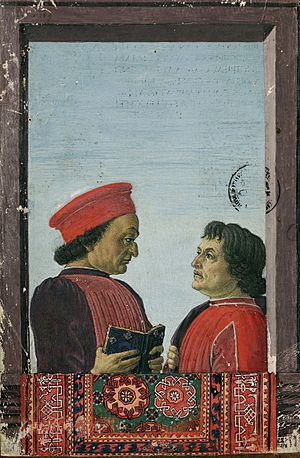
A Change in Appearance
In 1450, Federico was hired by Sforza, who was now the Duke of Milan. However, Federico had an accident during a tournament and lost his right eye. After this injury, he had surgeons remove the bridge of his nose and part of his eyelid. This helped him see better with his remaining eye, especially important for a military commander.
In 1453, Federico became ill with malaria. His luck changed in 1458 when Pius II, a Pope who also loved culture, made Federico the main military leader for the Church. Federico won many battles, especially against his old enemy, Malatesta. He defeated Malatesta in 1462 and captured Fano and Senigallia in 1463. The Pope then made Federico the ruler of these new lands.
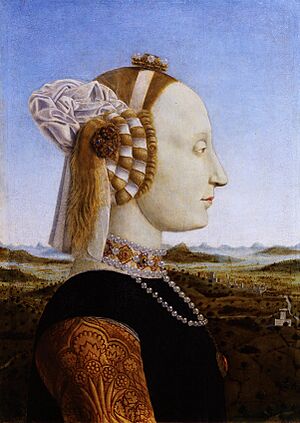
Later Years and Family Life
In 1464, the new Pope, Paul II, asked Federico to help regain control of lands in northern Lazio. Federico continued to fight for the Pope and other powerful families like the Sforza. In 1467, he fought in the Battle of Molinella.
In 1469, Federico was sent to take Rimini. But instead of giving it to the Pope, he gave it to Sigismondo's son, Roberto Malatesta. This showed Federico's cleverness in balancing power.
In 1474, Pope Sixtus IV made Federico the Duke of Urbino. This was a great honor. The Pope also arranged for Federico's daughter, Giovanna, to marry his nephew.
Federico's second wife, Battista Sforza, was very important to him. She died in 1472 after giving birth to their seventh child. Federico was very sad, calling her "the delight of my public and private hours." He spent much of his time in his beautiful palace in Urbino after her death.
In 1482, Federico was asked to lead an army for Ercole d'Este I in a war against Venice. He became ill with a fever and died in September of that year.
Federico's son, Guidobaldo, became the next Duke. When Guidobaldo died in 1508, the Duchy of Urbino passed to the Della Rovere family, who were relatives of the Pope.
Federico's Achievements
Supporting Arts and Culture
Federico was called "the Light of Italy" because he did so much for culture during the Renaissance. He made sure his small state was fair and stable. He hired the best copyists to create a huge library, second only to the Vatican's. He also supported many artists, including the famous painter Raphael when he was young.
Federico had a special room called a studiolo in his palaces in Urbino and Gubbio. These rooms were designed for quiet thinking. They were famous for their amazing trompe-l'œil decorations, which are paintings that trick your eye into thinking they are real objects. The studiolo from Gubbio is now in The Metropolitan Museum of Art in New York.
His Role in Society
Federico cared deeply for his people and his soldiers. He made sure that if soldiers were hurt or killed, their families were looked after. For example, he provided money for their daughters to get married. He often walked around Urbino without guards, talking to people in shops and asking how they were doing. He believed that all male citizens of Urbino were equal under the law, no matter their social rank.
He loved to study history and philosophy. Even though he was a military leader, he was also a scholar.
Federico's military successes helped him pay for all his cultural projects. People said his soldiers were very loyal because he always looked out for them. He never lost a war and received many military honors. Edward IV of England even made him a Knight of the Order of the Garter, a very special award. You can see the Garter band on his left knee in his portrait by Pedro Berruguete.
Images for kids
See also
 In Spanish: Federico da Montefeltro para niños
In Spanish: Federico da Montefeltro para niños
- Wars in Lombardy
- Dukes of Urbino
- Condottieri
- Antonio da Montefeltro
- Sigismondo Pandolfo Malatesta
- Holy Conversation (Piero della Francesca)
- Diptych of Federico da Montefeltro and Battista Sforza


